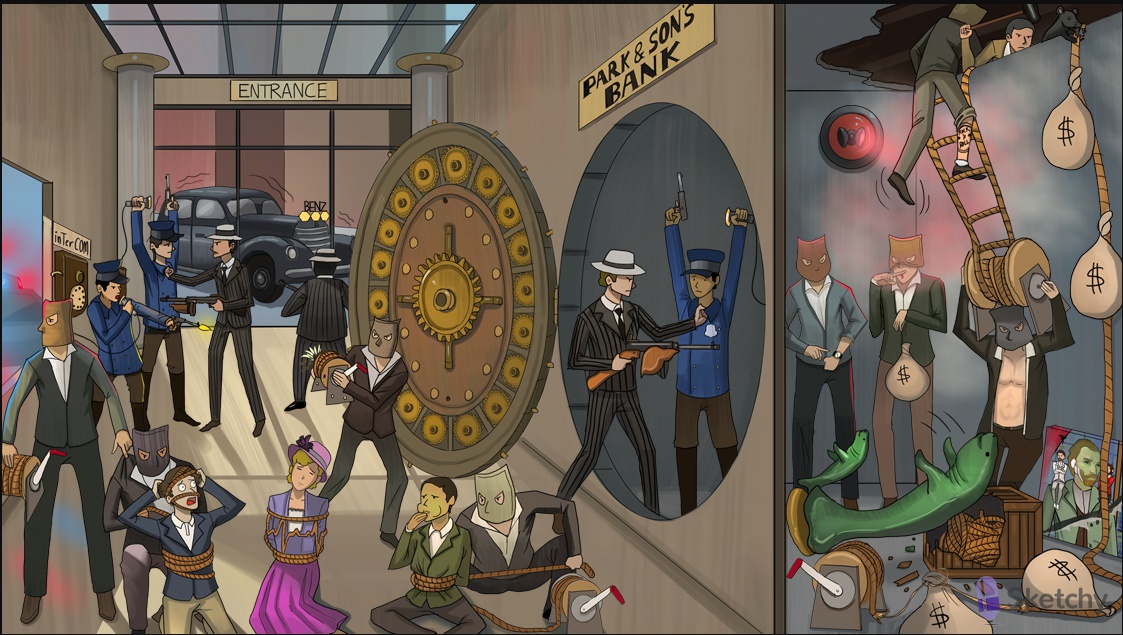Parkinson

Cracked open cogwheels: parkinsonism therapy
Lovodopa

Bank vault threshold: blood brain barrier (BBB)
"L" rope crank inside vault: levodopa (L-DOPA) crosses the BB
Unfurled/untangled rope in vault: levodopa is converted to dopamine by DOPA decarboxylase in the CNS

Unfurled rope in lobby: levodopa is converted to dopamine by DOPA decarboxylase in the periphery (can't cross BBB)
Nauseated hostage: levodopa can cause GI distress (due to peripheral conversion into dopamine). Vomiting from triggering of peripheral chemoreceptors
Arrhythmia rope: levodopa can cause cardiac arrhythmias (due to peripheral conversion into dopamine) (tachy, afib, Ventricular asystole)
Passed out hostage: levodopa can cause orthostatic hypotension (due to peripheral conversion into dopamine)
Psychiatrically disturbed hostage: levodopa can cause neuropsychiatric symptoms e.g. anxiety, agitation, insomnia, confusion, hallucination (due to excess dopamine in the CNS)

End of rope wearing-off: chronic levodopa therapy can cause a wearing-off reaction (akinesia and dyskinesia re-emerge at the end of each dose)
"Too long!": chronic levodopa therapy can cause response fluctuations (wearing-off reaction, on-off phenomenon) and dyskinesias
Flashing on and off: chronic levodopa therapy can cause an on-off phenomenon (periods of akinesia alternate with periods of improved mobility, not related to dose) (episodes of restrictive mobility in hours)
Narrowing window/watch: the therapeutic window of levodopa therapy narrows as Parkinson's progresses (unpredictable response to therapy). Too much dopamine: dyskinesia. Not enough dopamine: bradykinesia and regidity
Writhing sneeze: chronic levodopa therapy can cause dyskinesias (choreoathetosis of the face and distal extremities) (involuntary twisting of face and extremities)

Damaged psychotic painting: levodopa is contraindicated in psychotic patients (blocking CNS dopamine)
Carbidopa

Police car on periphery distracting: carbidopa (peripheral DOPA decarboxylase inhibitor) (cannot cross BBB)
Scared into vault: carbidopa increases the bioavailability of levodopa (prevents peripheral conversion into dopamine)
Pulling away from hostages: carbidopa decreases peripheral side effects of levodopa therapy (but exacerbates neuropsychiatric side effects)
COMT inhibitors

InTerCOM guard shooting "L" crank: catechol-O-methyltransferase (COMT) converts levodopa to 3-O-methyldopa (3-OMD) in the periphery
Tall Al Capone gangster: tolcapone (a peripheral and central COMT inhibitor) increases the bioavailability of levodopa
Al Capone gangster at entrance: entacapone (a peripheral COMT inhibitor) increases the bioavailability of levodopa
InTerCOM guard in vault: catechol-O-methyltransferase (COMT) converts dopamine to 3-methoxytyramine (3-MT) in the CNS
Tall gangster in vault: tolcapone (a peripheral and central COMT inhibitor) increases dopamine levels in CNS

Hepatic gun: tolcapone can cause hepatic failure
MAO inhibitors

Black mouse eating rope: monoamine oxidase B (MAO-B) selectively metabolizes dopamine
Sledge hammer: selegiline (a selective MAO-B inhibitor) increases dopamine levels in the CNS
D Agonists

Rope in a roll: ropinirole (D2 dopamine receptor agonists) is an important initial treatment of Parkinson's
Double rope ladder: D2 dopamine receptor
Big pecs: pramipexole (D3 dopamine receptor agonist) is an important initial treatment of Parkinson's

Restless legs: dopamine receptor agonists (e.g. ropinirole, pramipexole) treat restless leg syndrome (RLS)

"Rock and roll": dopamine receptor agonists (e.g. ropinirole) may enhance impulse control disorders (e.g. gambling, shopping, hypersexuality)
Amantaine

Manatee: amantadine can treat some motor symptoms of Parkinson's (originally antiviral influenza agent)
Breaking open rope: amantadine enhances the effect of endogenous dopamine (by increasing its synthesis/release and inhibiting its uptake)
Anti-M

Tri-hex Benz car: trihexyphenidyl and benztropine (antimuscarinic agents used to treat parkinsonism) (unbalanced high levels of Ach)
Trembling getaway car: trihexyphenidyl and benztropine (antimuscarinic agents) improve the tremor and rigidity of Parkinson's with no effect on bradykinesia
Last updated
Was this helpful?